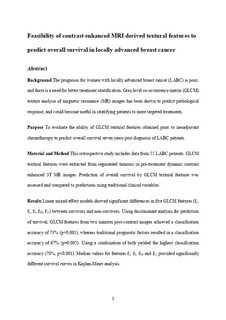| dc.contributor.author | Chronaiou, Ioanna | |
| dc.contributor.author | Giskeødegård, Guro F. | |
| dc.contributor.author | Goa, Pål Erik | |
| dc.contributor.author | Teruel, Jose | |
| dc.contributor.author | Hedayati, Roja | |
| dc.contributor.author | Lundgren, Steinar | |
| dc.contributor.author | Huuse, Else Marie | |
| dc.contributor.author | Pickles, Martin D. | |
| dc.contributor.author | Gibbs, Peter | |
| dc.contributor.author | Sitter, Beathe | |
| dc.contributor.author | Bathen, Tone Frost | |
| dc.date.accessioned | 2020-03-05T08:10:44Z | |
| dc.date.available | 2020-03-05T08:10:44Z | |
| dc.date.created | 2020-01-20T14:51:43Z | |
| dc.date.issued | 2019 | |
| dc.identifier.citation | Acta Radiologica. 2019, . | nb_NO |
| dc.identifier.issn | 0284-1851 | |
| dc.identifier.uri | http://hdl.handle.net/11250/2645376 | |
| dc.description.abstract | Background
The prognosis for women with locally advanced breast cancer (LABC) is poor and there is a need for better treatment stratification. Gray-level co-occurrence matrix (GLCM) texture analysis of magnetic resonance (MR) images has been shown to predict pathological response and could become useful in stratifying patients to more targeted treatments.
Purpose
To evaluate the ability of GLCM textural features obtained before neoadjuvant chemotherapy to predict overall survival (OS) seven years after diagnosis of patients with LABC.
Material and Methods
This retrospective study includes data from 55 patients with LABC. GLCM textural features were extracted from segmented tumors in pre-treatment dynamic contrast-enhanced 3-T MR images. Prediction of OS by GLCM textural features was assessed and compared to predictions using traditional clinical variables.
Results
Linear mixed-effect models showed significant differences in five GLCM features (f1, f2, f5, f10, f11) between survivors and non-survivors. Using discriminant analysis for prediction of survival, GLCM features from 2 min post-contrast images achieved a classification accuracy of 73% (P < 0.001), whereas traditional prognostic factors resulted in a classification accuracy of 67% (P = 0.005). Using a combination of both yielded the highest classification accuracy (78%, P < 0.001). Median values for features f1, f2, f10, and f11 provided significantly different survival curves in Kaplan–Meier analysis.
Conclusion
This study shows a clear association between textural features from post-contrast images obtained before neoadjuvant chemotherapy and OS seven years after diagnosis. Further studies in larger cohorts should be undertaken to investigate how this prognostic information can be used to benefit treatment stratification. | nb_NO |
| dc.language.iso | eng | nb_NO |
| dc.publisher | SAGE Publications | nb_NO |
| dc.title | Feasibility of contrast-enhanced MRI derived textural features to predict overall survival in locally advanced breast cancer. | nb_NO |
| dc.type | Journal article | nb_NO |
| dc.type | Peer reviewed | nb_NO |
| dc.description.version | acceptedVersion | nb_NO |
| dc.source.pagenumber | 10 | nb_NO |
| dc.source.journal | Acta Radiologica | nb_NO |
| dc.identifier.doi | 10.1177/0284185119885116 | |
| dc.identifier.cristin | 1778064 | |
| dc.description.localcode | © 2019. This is the authors' accepted and refereed manuscript to the article. The final authenticated version is available online at: https://doi.org/10.1177%2F0284185119885116 | nb_NO |
| cristin.unitcode | 194,65,25,0 | |
| cristin.unitcode | 194,66,20,0 | |
| cristin.unitcode | 1920,12,0,0 | |
| cristin.unitcode | 194,65,15,0 | |
| cristin.unitcode | 1920,4,0,0 | |
| cristin.unitname | Institutt for sirkulasjon og bildediagnostikk | |
| cristin.unitname | Institutt for fysikk | |
| cristin.unitname | Kreftklinikken | |
| cristin.unitname | Institutt for klinisk og molekylær medisin | |
| cristin.unitname | Klinikk for bildediagnostikk | |
| cristin.ispublished | true | |
| cristin.fulltext | postprint | |
| cristin.qualitycode | 1 | |
